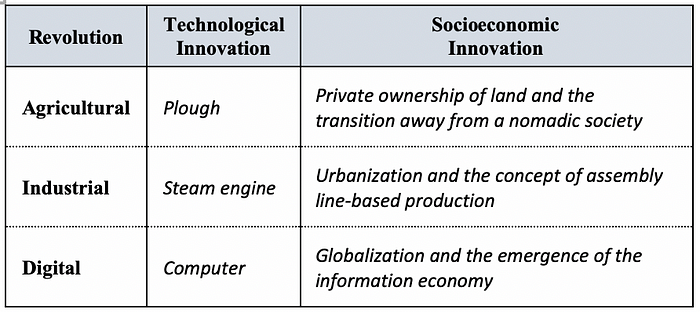Why we invest in sustainability
Eniac has been investing in sustainability for over a decade. It is an important space for us and a lifelong personal passion of mine. Over the years, we’ve found that our thesis in the space — and the investments we make as a result — often extend beyond the scope of just “climate.” I thought it would be helpful to explain our thinking, and why we’ve refined our investment thesis to center around sustainability rather than climate-tech.
One fundamental concept in biology is that every environment has a natural carrying capacity — the maximum population of a species that it can sustain. If a population exceeds an environment’s carrying capacity, the limited resources will begin to negatively impact that population, eventually decreasing its size. If a population remains above this line for too long, the over-use of resources can permanently degrade the environment, bringing the carrying capacity even lower.
Now, as extreme storms, droughts, and wildfires cripple communities with increasing frequency, all against the backdrop of a raging global pandemic, it is clear that we‘ve begun to hit our planet’s carrying capacity.
In order to survive and grow as a species, we need to be able to develop sustainably — that is, we need to exist in a way that does not diminish the ability of our environment to support more growth. It sounds simple but in reality it is a dramatic departure from our current paradigm. For the first time in history, humanity must figure out how to operate in a manner that factors in the constraint of finite global resources.
We’ve experienced change of this magnitude before — the agricultural, industrial, and digital revolutions all dramatically altered our capacity for production, meaningfully increasing the human population that earth was able to support. In each of these cases, the post-revolution reality was made possible not just by technological innovations but also by a restructuring of prevailing social and economic norms.

Now we stand at the precipice of another revolution, where another step function change is needed — this time one that turns us into a society capable of sustainable development. And just like the revolutions that came before, this one will be driven by a combination of both technological and socio-economic innovation.
The urgency of climate change has pushed us to drastic, emergency measures that lean heavily on technological innovation. To stave off the worst outcomes, it is imperative that we create and propagate new technology that allows us to reduce emissions, to generate and store clean energy, and to remove and permanently sequester carbon from the air. And beyond the immediate threats, advancements in robotics, synthetic biology, and AI and machine learning (among many others) all have important parts to play in driving us towards a more efficient and sustainable future.
However, technological innovation on its own is just a salve for a more systemic problem — a society that was built on the assumption that natural resources would never be a limiting factor. New technology will increase the earth’s carrying capacity, but as long as our socio-economic infrastructure is predicated on extraction and consumption, eventually our population will again hit a ceiling where the earth can no longer support more growth.
To permanently solve this problem, we must figure out how to transition to a society that is not extractive but regenerative. When our actions and development result in the net regeneration of the environment around us instead of its degradation, they can continue in perpetuity.
In order to survive we must go from a species that centers our culture, economy, and social structures around consumption to one that centers around stewardship.
Making that transition requires us to go back to the drawing board and rebuild parts of our world based on these new first principles. Supply chains must be rebuilt such that they are circular and hyper-efficient. How we use and interact with every kind of asset needs to be reexamined, in order to find ways to extend usability. Economic incentive structures must be realigned in order to properly account for environmental externalities and to move us away from an economy based on zero-sum extraction. Data must be made accessible so our actions and their impacts on our environment can be properly measured and incorporated into our decision-making. People must be educated and given opportunities for upskilling in order to participate in this new economy, and communities must be cultivated and supported as we increasingly move towards a society where communal collaboration is necessary for the stewardship of communal assets.
In other words, it is not enough to invent better technologies, we must also invent new economic and social structures around them.
This is how we think about investing in sustainability at Eniac. We’re not just looking to invest in climate-tech, we’re looking for companies that are fundamentally reimagining the socio-economic and technological fabric of our world, so as to create global systems that are resilient and regenerative in the face of limited resources and a growing population.
Many of our investments still fall squarely into the “climate” category. Vence automates rotational cattle grazing for farmers (a form of regenerative agriculture) while also providing them with a treasure trove of data to improve herd health. Bedrock enables offshore wind development with cheap, reliable surveys that will eventually transform the way we access and use seafloor data. And Iron Ox is leveraging innovations in autonomy to increase agricultural efficiency, while also reimagining supply chains in a way that will dramatically impact land use and urbanization.
Sometimes however, the investments we make through this thesis are less obviously tied to climate, and instead reflect our belief in the importance of building sustainable systems. We recently made an investment in robotics data infrastructure that few would categorize as a “climate” investment. However, imagine the enormous implications for sustainability if the time and capital required to scale robotics companies were cut in half. Similarly, one of our companies is building a satellite-based data analytics layer that is technically sector-agnostic, but by being horizontal they are able to power downstream solutions focused on climate risk in a way that is much more comprehensive, scalable, and accessible than if they were focusing on climate alone. And while the negative climate impacts of blockchain in its current form are still problematic, our investments in Web3 provide a glimpse into a future where decentralized ownership can effectively align stakeholder incentives with those of a broader community — something that will be essential for transitioning to an economy centered around mutualism.
These investments were not made as investments in “climate-tech” but because we believe each one of them is contributing to a totally new paradigm for how our world will work. The lens is admittedly broad, but we believe it has to be in order for us to truly step back and rethink our social, economic, and physical infrastructure within every sector, scale, and temporal horizon. The most impactful solutions will be those that radically re-orient huge segments of our economy. Doing so will require a combination of technological and socio-economic innovation and will certainly touch many things beyond just “climate.”
At Eniac we are well positioned to invest in this nexus. We are generalists that have worked and invested across many industries, and have the knowledge base and network to build and scale within them. And with a portfolio that is nearly 30% deep tech, we also have the experience and the appetite to invest in hard problems, and know that doing so is necessary to move the needle.
There are a number of areas we’re excited about, including enabling renewable energy, building circular economies, reimagining the grid, creating efficient supply chains, and finding ways to internalize environmental externalities such as pollution and ecosystem services into our economies, among many others. But we also fully expect that most of our investments will be in visionary founders building solutions we haven’t yet imagined.
Our views and work in the space will continue to evolve and we look forward to sharing more as they do so. In the meantime, if you are a founder, investor, operator, academic or any other human who is interested in building a sustainable future and want to collaborate or share your thoughts, feel free to reach out via email at kristin@eniac.vc or on Twitter @kristinEIise.
